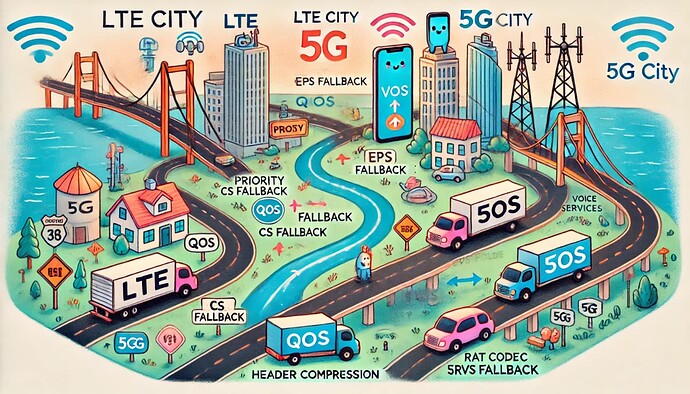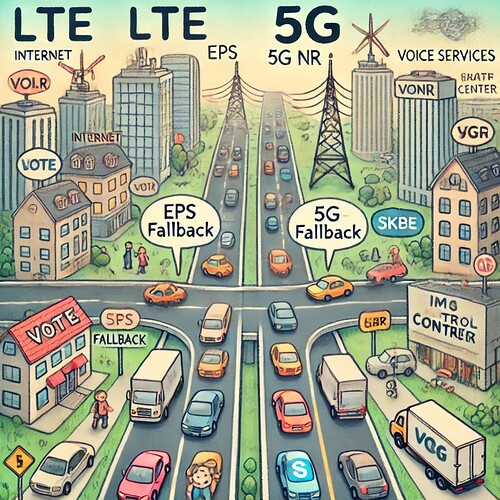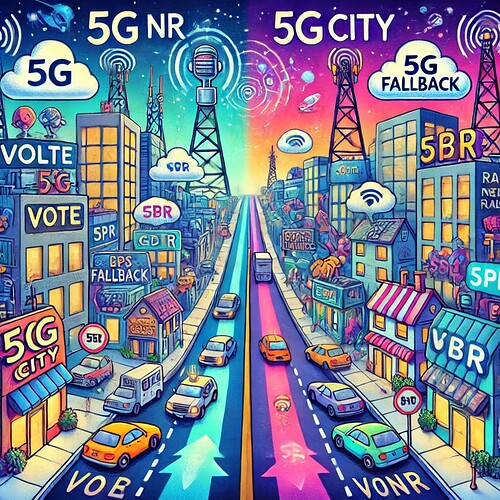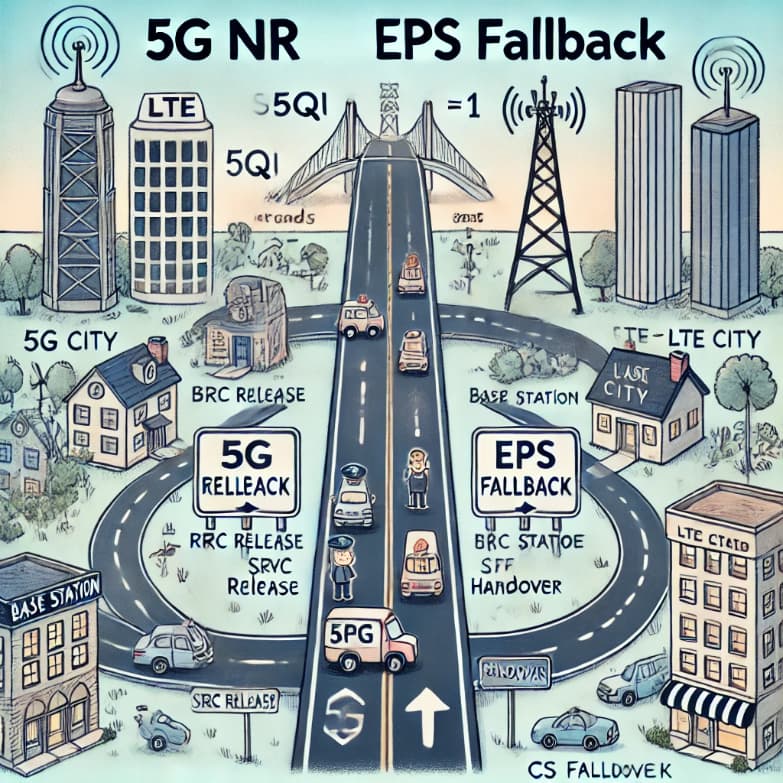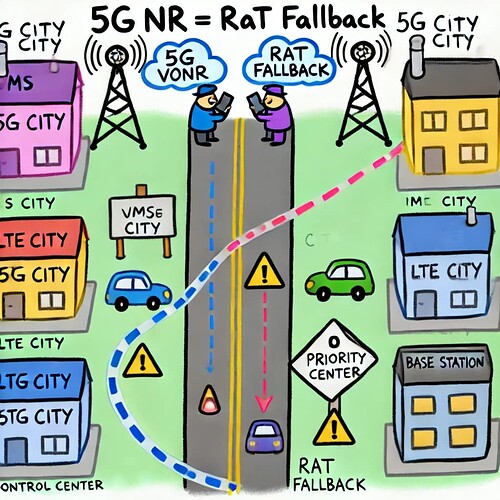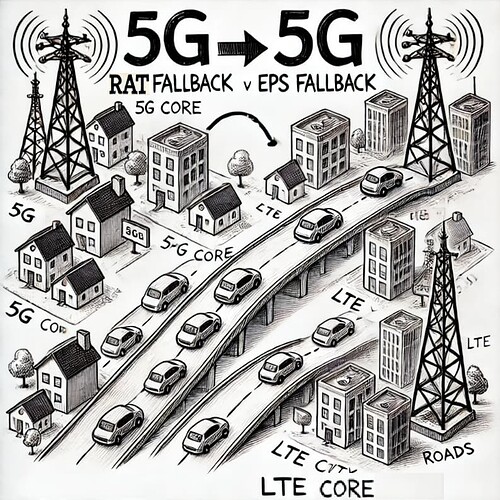This topic presents in a very simplified way all the main concepts that should be understood by those who know 5G NR.
5G NR Voice Services
LTE and 5G networks handle voice calls through advanced packet-based systems instead of the traditional circuit-switched methods used by 2G and 3G. LTE introduced Voice over LTE (VoLTE), which uses the IP Multimedia Subsystem (IMS) for call management, supported by Evolved Packet Core (EPC) and QoS mechanisms like GBR bearers to prioritize call quality. When LTE cannot provide adequate coverage for calls, it uses fallback methods like CS Fallback (switching to 2G/3G) or Single Radio Voice Call Continuity (SRVCC) to maintain connections. 5G expands this with Voice over New Radio (VoNR), which operates similarly to VoLTE but leverages 5G Core (5GC) and QoS Flows with identifiers like 5QI = 1 for high-priority voice packets. Early 5G deployments often rely on fallback options, such as EPS Fallback (to 4G) or RAT Fallback (changing to LTE while staying on 5GC), due to limited coverage. Key technologies like the Enhanced Voice Services (EVS) codec, header compression (e.g., Robust Header Compression or RoHC), and advanced Radio Access Network (RAN) features (e.g., DRX, semi-persistent scheduling) ensure low latency, efficient resource use, and excellent call quality. These systems enable seamless voice services across evolving network infrastructures. [In a Nutshell: LTE and 5G rely on advanced data systems, IMS, and QoS to manage voice calls, with fallback methods like EPS and RAT Fallback ensuring continuity, while tools like EVS and RoHC enhance call quality and efficiency.]
![]() Imagine LTE and 5G as two amazing cities that help people make phone calls. In the older cities (2G and 3G), there were special phone booths on every corner just for calls. But in the LTE city, those phone booths are gone, and instead, people talk through the internet highways, like sending voice messages over super-fast internet roads. To make sure these calls are smooth and clear, there are priority lanes (called QoS) that speed up important traffic, like phone calls, so they don’t get stuck behind emails or videos. Sometimes, though, the LTE city doesn’t have strong enough roads everywhere for calls. In those cases, it borrows roads from the older cities (using CS Fallback) or uses shortcuts through connecting bridges (SRVCC) to keep the call going. Now, in the 5G city, everything is even better and faster! It has brand-new highways designed for speed and reliability. It uses a system called VoNR, which is like having its own dedicated expressways for phone calls. But because the 5G city is still under construction in some places, it sometimes sends people back to the LTE city for their calls using special detours called EPS Fallback or RAT Fallback. Both cities work together using clever tools like high-quality microphones (EVS codec) and compact packages (header compression) to make sure everyone’s calls are clear and use the least amount of resources, just like efficient delivery trucks. This way, people in both cities can always stay connected, no matter where they are! [In a Nutshell: LTE and 5G cities use advanced roads and clever detours to ensure voice calls are always clear and uninterrupted, even if one city needs help from the other.]
Imagine LTE and 5G as two amazing cities that help people make phone calls. In the older cities (2G and 3G), there were special phone booths on every corner just for calls. But in the LTE city, those phone booths are gone, and instead, people talk through the internet highways, like sending voice messages over super-fast internet roads. To make sure these calls are smooth and clear, there are priority lanes (called QoS) that speed up important traffic, like phone calls, so they don’t get stuck behind emails or videos. Sometimes, though, the LTE city doesn’t have strong enough roads everywhere for calls. In those cases, it borrows roads from the older cities (using CS Fallback) or uses shortcuts through connecting bridges (SRVCC) to keep the call going. Now, in the 5G city, everything is even better and faster! It has brand-new highways designed for speed and reliability. It uses a system called VoNR, which is like having its own dedicated expressways for phone calls. But because the 5G city is still under construction in some places, it sometimes sends people back to the LTE city for their calls using special detours called EPS Fallback or RAT Fallback. Both cities work together using clever tools like high-quality microphones (EVS codec) and compact packages (header compression) to make sure everyone’s calls are clear and use the least amount of resources, just like efficient delivery trucks. This way, people in both cities can always stay connected, no matter where they are! [In a Nutshell: LTE and 5G cities use advanced roads and clever detours to ensure voice calls are always clear and uninterrupted, even if one city needs help from the other.]
Skip to: Roadmap to 5G NR
Voice Services
In earlier networks like 2G and 3G, voice calls relied on dedicated circuits, but LTE introduced packet-switched systems, which are more efficient and flexible. To maintain calls when LTE coverage is insufficient, it uses mechanisms like CS Fallback to switch back to older networks. LTE also brought Voice over LTE (VoLTE), which uses the IP Multimedia Subsystem (IMS) for managing calls over data networks, ensuring higher efficiency and better call quality through priority mechanisms like GBR bearers. However, OTT apps like Skype and WhatsApp provide voice services without these priorities, leading to lower call quality during congestion. With 5G, voice services advance further through Voice over New Radio (VoNR), which uses an enhanced architecture for faster and more reliable communication. Fallback options like EPS Fallback and RAT Fallback help maintain continuity in areas with limited 5G coverage, ensuring compatibility with LTE-based voice services for a smooth transition in early deployments. [In a Nutshell: LTE and 5G improve voice services with advanced systems, while fallback options ensure uninterrupted calls when coverage is limited.]
![]() Imagine LTE and 5G as two neighboring cities that help people make phone calls. In the older cities (2G and 3G), people had their own private phone booths to talk, but it wasn’t very efficient. In LTE City, phone calls travel through special internet roads called VoLTE, which are fast and well-organized, with priority lanes for important calls to keep them smooth. Some apps like Skype and WhatsApp also let people talk, but they use the regular crowded roads, so calls can get delayed. Now, in 5G City, the roads are even faster and smarter with a system called VoNR, designed for better and quicker calls. But if the roads in 5G City aren’t ready yet, they can direct cars (calls) back to LTE City using clever detours like EPS Fallback or RAT Fallback to make sure the conversation never stops, keeping everyone connected no matter where they are. [In a Nutshell: LTE and 5G cities use modern roads and detours to ensure phone calls are always fast, smooth, and connected, even if one city helps the other.]
Imagine LTE and 5G as two neighboring cities that help people make phone calls. In the older cities (2G and 3G), people had their own private phone booths to talk, but it wasn’t very efficient. In LTE City, phone calls travel through special internet roads called VoLTE, which are fast and well-organized, with priority lanes for important calls to keep them smooth. Some apps like Skype and WhatsApp also let people talk, but they use the regular crowded roads, so calls can get delayed. Now, in 5G City, the roads are even faster and smarter with a system called VoNR, designed for better and quicker calls. But if the roads in 5G City aren’t ready yet, they can direct cars (calls) back to LTE City using clever detours like EPS Fallback or RAT Fallback to make sure the conversation never stops, keeping everyone connected no matter where they are. [In a Nutshell: LTE and 5G cities use modern roads and detours to ensure phone calls are always fast, smooth, and connected, even if one city helps the other.]
- Search Forum
 Voice Services:new_tab:
Voice Services:new_tab:
Voice over New Radio
Voice over New Radio (VoNR) in 5G enhances Voice over LTE (VoLTE) by leveraging 5G’s advanced infrastructure for faster and more reliable voice services. Both rely on the IP Multimedia Subsystem (IMS) for call setup and management, using Session Initiation Protocol (SIP) for signaling. VoNR uses QoS Flows with 5QI = 5 for signaling and 5QI = 1 for high-priority voice packets, ensuring low latency and high reliability. It employs the Enhanced Voice Services (EVS) codec for superior audio quality, supporting adaptive bit rates and compatibility with legacy systems. To optimize resource use, VoNR utilizes Robust Header Compression (RoHC) to minimize protocol overhead, Discontinuous Reception (DRX) for energy efficiency, and techniques like Semi-Persistent Scheduling (SPS) to reduce control signaling. VoNR operates over 5G’s PDU Sessions, connecting the User Plane Function (UPF) to IMS via the N6 interface. When coverage is incomplete, fallback mechanisms like EPS Fallback or RAT Fallback ensure smooth transitions to LTE, preserving continuous, high-quality voice communication. VoNR is a major step forward, offering lower latency, higher capacity, and improved user experience compared to LTE. [In a Nutshell: VoNR builds on VoLTE by using 5G’s advanced features for faster, clearer, and more reliable voice calls, with fallback options ensuring seamless communication in weak 5G areas.]
![]() Imagine LTE and 5G as two neighboring cities where people make phone calls. In LTE City, phone calls travel through well-organized streets called VoLTE, which are managed by a smart control center (IMS). But in 5G City, there’s an even faster and smarter system called VoNR with special express lanes (5QI) for voice calls and important signals, ensuring everything moves smoothly and quickly. These calls are crystal clear because of a magical microphone (EVS codec) that adapts to the environment. To save energy, 5G City uses smart streetlights (DRX) that turn on only when needed and plans traffic in advance (SPS) to avoid jams. If 5G City roads aren’t ready yet, clever detours like EPS Fallback or RAT Fallback send cars (calls) back to LTE City without stopping the conversation, making sure everyone stays connected, no matter where they are. [In a Nutshell: LTE and 5G cities work together to ensure voice calls are smooth, fast, and clear, using advanced tools and clever detours when needed.]
Imagine LTE and 5G as two neighboring cities where people make phone calls. In LTE City, phone calls travel through well-organized streets called VoLTE, which are managed by a smart control center (IMS). But in 5G City, there’s an even faster and smarter system called VoNR with special express lanes (5QI) for voice calls and important signals, ensuring everything moves smoothly and quickly. These calls are crystal clear because of a magical microphone (EVS codec) that adapts to the environment. To save energy, 5G City uses smart streetlights (DRX) that turn on only when needed and plans traffic in advance (SPS) to avoid jams. If 5G City roads aren’t ready yet, clever detours like EPS Fallback or RAT Fallback send cars (calls) back to LTE City without stopping the conversation, making sure everyone stays connected, no matter where they are. [In a Nutshell: LTE and 5G cities work together to ensure voice calls are smooth, fast, and clear, using advanced tools and clever detours when needed.]
- Search Forum
 5G NR Voice over New Radio
5G NR Voice over New Radio 
EPS Fallback
EPS Fallback is a mechanism used to enable voice calls when a UE connected to the 5G Core Network (5GC) and using New Radio (NR) transitions to a 4G network (EUTRA) to complete the call. This is essential in early 5G deployments, where the 5G network may lack robust coverage or support for the high-priority QoS Flow with 5QI = 1 needed for voice services. When an IMS voice call is initiated, the Base Station determines if fallback is needed, rejecting the setup of the 5QI = 1 flow and redirecting the UE to the 4G network through RRC Release with Redirection or handover. Once on the 4G network, the UE completes a Tracking Area Update or Attach procedure, and the IMS call setup proceeds using a dedicated EPS Bearer with QCI = 1. EPS Fallback supports interworking with legacy 2G/3G networks through mechanisms like SRVCC or CS Fallback if needed. This seamless transition ensures continuous voice call capability, leveraging IMS and existing VoLTE features. Support for EPS Fallback is inferred if the UE indicates VoLTE compatibility, with specific signaling flags used to coordinate the procedure. [In a Nutshell: EPS Fallback shifts calls from 5G to 4G to ensure reliable voice services when 5G coverage or support is insufficient.]
![]() Imagine LTE and 5G as two cities connected by a bridge. In 5G City, phone calls usually travel on super-fast roads with special priority lanes (5QI = 1) for voice calls. But sometimes, 5G City doesn’t have enough roads built yet, so it sends the call over the bridge to LTE City using a clever system called EPS Fallback. The Base Station acts like a traffic officer, deciding when to redirect calls to LTE City using safe routes (RRC Release or handover). Once in LTE City, the call gets set up on a reliable lane (QCI = 1) and continues without interruption. If needed, the call can even take older paths in 2G or 3G cities using systems like SRVCC or CS Fallback. This ensures calls never drop and everyone stays connected, even if 5G roads aren’t fully ready yet. [In a Nutshell: EPS Fallback ensures seamless voice calls by redirecting from 5G to LTE when 5G roads aren’t ready, keeping everyone connected.]
Imagine LTE and 5G as two cities connected by a bridge. In 5G City, phone calls usually travel on super-fast roads with special priority lanes (5QI = 1) for voice calls. But sometimes, 5G City doesn’t have enough roads built yet, so it sends the call over the bridge to LTE City using a clever system called EPS Fallback. The Base Station acts like a traffic officer, deciding when to redirect calls to LTE City using safe routes (RRC Release or handover). Once in LTE City, the call gets set up on a reliable lane (QCI = 1) and continues without interruption. If needed, the call can even take older paths in 2G or 3G cities using systems like SRVCC or CS Fallback. This ensures calls never drop and everyone stays connected, even if 5G roads aren’t fully ready yet. [In a Nutshell: EPS Fallback ensures seamless voice calls by redirecting from 5G to LTE when 5G roads aren’t ready, keeping everyone connected.]
- Search Forum
 5G NR EPS Fallback
5G NR EPS Fallback 
RAT Fallback
RAT Fallback allows a UE connected to the 5G Core Network (5GC) via New Radio (NR) to complete IMS voice calls using the EUTRA Radio Access Network while maintaining its connection to the 5GC. This is useful when the NR network lacks coverage or is not configured for IMS voice. The fallback begins when the Base Station determines the need, rejects the QoS Flow setup for 5QI = 1, and redirects the UE to EUTRA using RRC Reconfiguration. Once connected to EUTRA, the IMS call setup continues, and the QoS Flow for voice packets is either maintained on EUTRA or moved back to NR. This approach allows seamless voice services without explicitly requiring the UE to indicate RAT Fallback support, relying instead on standard IMS and fallback signaling flags. It ensures voice calls are uninterrupted, leveraging both 5G and 4G capabilities for reliability and flexibility. [In a Nutshell: RAT Fallback redirects voice calls to 4G’s network for traffic while staying connected to 5G’s system, ensuring uninterrupted communication.]
![]() Imagine LTE and 5G as two neighboring cities connected by flexible pathways. In 5G City, voice calls usually travel on high-speed roads designed for IMS voice calls. However, if some roads in 5G City aren’t ready or aren’t built for voice calls, a smart traffic officer (Base Station) redirects the call to LTE City using RAT Fallback. This is like switching to well-maintained LTE roads (EUTRA) while keeping the connection to the 5G City’s control center (5GC) intact. Once in LTE City, the call setup continues seamlessly, and the priority lanes (QoS Flow 5QI = 1) can either stay in LTE City or move back to 5G City when the roads there are ready. This clever system keeps voice calls smooth and reliable, combining the strengths of both cities without needing special instructions from the traveler (UE). [In a Nutshell: RAT Fallback lets LTE carry voice traffic while staying connected to 5G’s system, ensuring smooth and uninterrupted calls.]
Imagine LTE and 5G as two neighboring cities connected by flexible pathways. In 5G City, voice calls usually travel on high-speed roads designed for IMS voice calls. However, if some roads in 5G City aren’t ready or aren’t built for voice calls, a smart traffic officer (Base Station) redirects the call to LTE City using RAT Fallback. This is like switching to well-maintained LTE roads (EUTRA) while keeping the connection to the 5G City’s control center (5GC) intact. Once in LTE City, the call setup continues seamlessly, and the priority lanes (QoS Flow 5QI = 1) can either stay in LTE City or move back to 5G City when the roads there are ready. This clever system keeps voice calls smooth and reliable, combining the strengths of both cities without needing special instructions from the traveler (UE). [In a Nutshell: RAT Fallback lets LTE carry voice traffic while staying connected to 5G’s system, ensuring smooth and uninterrupted calls.]
- Search Forum
 5G NR RAT Fallback
5G NR RAT Fallback 
EPS Fallback vs. RAT Fallback
The main difference between EPS Fallback and RAT Fallback is how they handle voice calls when 5G coverage or support for voice services is limited. EPS Fallback moves the call entirely from the 5G core and network to the 4G core and network for the entire duration of the call. It’s like switching completely to LTE City when 5G City can’t handle the call. RAT Fallback, on the other hand, keeps the call connected to the 5G core but uses LTE (EUTRA) for the voice traffic. The key difference lies in which core network is used during the fallback scenario. In essence, EPS Fallback is a complete switch to the 4G network, involving both the radio access network and the core network, while RAT Fallback is a partial switch, where the radio access technology changes from 5G NR to 4G LTE, but the core network remains 5G. The choice between these two fallback mechanisms depends on factors like 5G network coverage, device capabilities, and operator preferences. [In a Nutshell: EPS Fallback fully shifts calls to LTE, while RAT Fallback keeps calls connected to 5G’s system but uses LTE’s roads for voice traffic.]
![]() Imagine you’re on a road trip starting in 5G City but need help to finish your journey because some roads are missing. EPS Fallback is like deciding to completely move to LTE City for the rest of your trip. You switch to LTE City’s roads and traffic system to reach your destination. RAT Fallback is like staying connected to 5G City’s control center but borrowing LTE City’s roads temporarily to get through. Once the roads in 5G City are ready, you can move back without leaving the trip managed by 5G City. Both ensure you keep going, but one moves you entirely, and the other keeps you connected while borrowing help. [In a Nutshell: EPS Fallback moves your entire trip to LTE City, while RAT Fallback uses LTE’s roads while staying connected to 5G City’s system.]
Imagine you’re on a road trip starting in 5G City but need help to finish your journey because some roads are missing. EPS Fallback is like deciding to completely move to LTE City for the rest of your trip. You switch to LTE City’s roads and traffic system to reach your destination. RAT Fallback is like staying connected to 5G City’s control center but borrowing LTE City’s roads temporarily to get through. Once the roads in 5G City are ready, you can move back without leaving the trip managed by 5G City. Both ensure you keep going, but one moves you entirely, and the other keeps you connected while borrowing help. [In a Nutshell: EPS Fallback moves your entire trip to LTE City, while RAT Fallback uses LTE’s roads while staying connected to 5G City’s system.]
- Search Forum
 EPS Fallback vs RAT Fallback
EPS Fallback vs RAT Fallback 
Quick Summary
-
Voice Services: LTE and 5G enhance voice calls with efficient, high-quality systems like VoLTE and VoNR, while fallback options like EPS and RAT Fallback ensure smooth communication when coverage is limited. (LTE and 5G work together to ensure seamless, high-quality voice services, with fallback bridges for uninterrupted communication.)
-
Voice over New Radio: VoNR improves on VoLTE by leveraging 5G’s advanced features for faster, clearer, and more reliable voice calls, with fallback options ensuring seamless communication in limited 5G coverage areas. (LTE and 5G cities work together for seamless voice communication, with VoLTE and VoNR roads ensuring reliable calls, magical microphones for clear audio, smart tools for efficiency, and fallback bridges to maintain uninterrupted services.)
-
EPS Fallback: EPS Fallback moves calls from 5G to 4G to ensure reliable voice services when 5G coverage or support is limited. (EPS Fallback seamlessly redirects calls from 5G to LTE over a bridge when 5G roads are unavailable.)
-
RAT Fallback: RAT Fallback uses 4G for voice traffic while keeping the call connected to 5G’s system, ensuring seamless and uninterrupted communication. (RAT Fallback redirects calls to LTE’s roads when 5G roads are unavailable, keeping them connected to 5G’s control system.)
-
EPS Fallback vs. RAT Fallback: EPS Fallback fully shifts calls to LTE’s core and network, while RAT Fallback keeps calls connected to 5G’s core but uses LTE’s roads for voice traffic. (EPS Fallback moves calls entirely to LTE City, switching both the network core and roads, while RAT Fallback keeps calls connected to 5G City’s core but temporarily uses LTE City’s roads.)
That’s it. ![]()
-
Continue reading: Roadmap to 5G NR - Signalling Procedures
-
Or back to: Roadmap to 5G NR
